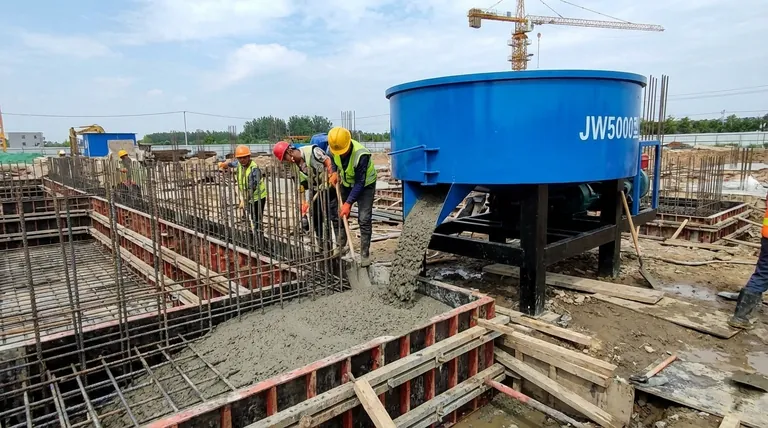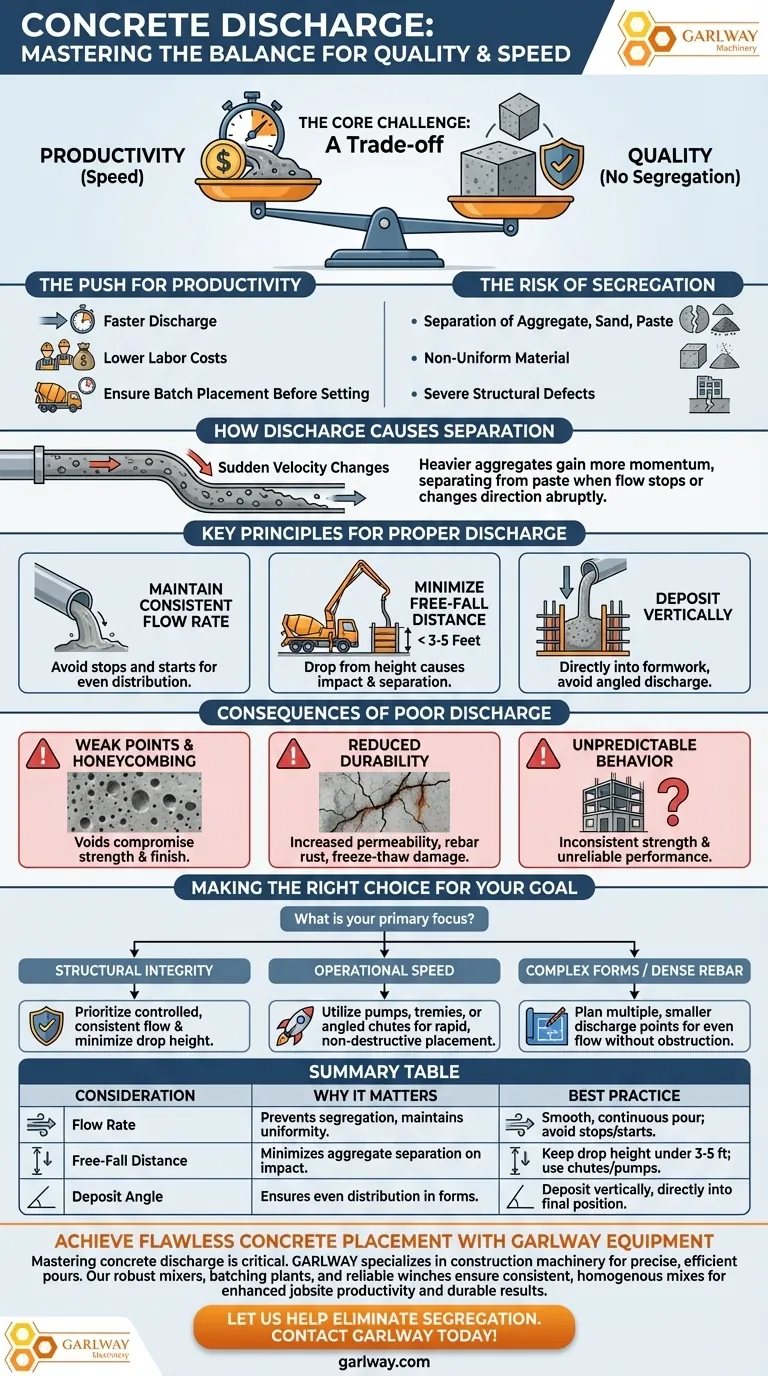The most critical considerations for concrete discharge are balancing the speed of the pour with the need to maintain a uniform, homogenous mix. The primary goal is to move the concrete from the truck or pump to its final position without causing the heavy aggregates to separate from the cement paste, a defect known as segregation.
The central challenge of concrete discharge is a trade-off between productivity and quality. Discharging too quickly or carelessly can ruin the concrete's internal structure, compromising the strength and durability of the final product.

The Core Challenge: Speed vs. Quality
Every construction project operates under tight schedules, creating a natural pressure to place concrete as quickly as possible. However, the physics of a semi-liquid material like concrete imposes strict limits on how it can be handled.
The Push for Productivity
Faster discharge directly translates to lower labor costs and helps ensure the entire batch is placed before it begins to set. This operational efficiency is a constant and valid business driver on any job site.
The Risk of Segregation
Segregation is the separation of concrete's constituent parts—coarse aggregate, fine aggregate (sand), and cement paste. When this happens, the resulting concrete is no longer a uniform material, leading to severe structural defects.
How Discharge Causes Separation
Sudden changes in velocity are the primary cause of segregation during discharge. As the concrete flows, the heavier coarse aggregates gain more momentum than the lighter cement paste. If the flow stops or changes direction abruptly, these aggregates can separate from the mix.
Key Principles for Proper Discharge
To mitigate the risks of segregation and ensure a high-quality pour, you must control the flow of concrete from the point of discharge to its final placement.
Maintain a Consistent Flow Rate
Avoid starting and stopping the pour unnecessarily. A smooth, continuous flow helps keep all the components suspended and evenly distributed within the mix.
Minimize Free-Fall Distance
Dropping concrete from a significant height is one of the most common causes of segregation. The impact forces the heavier aggregates to separate. Always discharge concrete as close to its final position as possible, ideally less than 3 to 5 feet.
Deposit Vertically
Concrete should always be deposited vertically, directly into the formwork. Discharging at an angle can cause the material to separate as it hits the formwork or reinforcing steel.
Understanding the Consequences of Poor Discharge
Failing to manage the discharge process properly can lead to costly and dangerous structural flaws that may not be immediately obvious.
Weak Points and Honeycombing
Areas where aggregates have collected without sufficient cement paste to bind them create weak zones known as "honeycombing." These voids compromise the concrete's compressive strength and create a poor surface finish.
Reduced Durability
Segregated concrete is more permeable. Pockets of coarse aggregate allow water and corrosive agents to penetrate the structure, leading to rebar rust, freeze-thaw damage, and a drastically reduced service life.
Unpredictable Structural Behavior
The goal of concrete design is to create a predictable, homogenous material. Segregation undermines this entirely, resulting in a structure with inconsistent strength and unreliable performance under load.
Making the Right Choice for Your Goal
Controlling the discharge is not about choosing one factor over another; it's about using the right techniques to achieve both speed and quality.
- If your primary focus is structural integrity: Prioritize a controlled, consistent flow rate, minimizing drop height above all else to prevent segregation.
- If your primary focus is operational speed: Utilize equipment like concrete pumps, tremies, or properly angled chutes that enable rapid placement without causing a destructive free-fall.
- If you are placing into complex forms or around dense rebar: Plan multiple, smaller discharge points to ensure concrete flows evenly without separating as it navigates obstructions.
Mastering the final step of concrete placement is a non-negotiable part of ensuring the finished structure is safe, strong, and durable.
Summary Table:
| Consideration | Why It Matters | Best Practice |
|---|---|---|
| Flow Rate | Prevents segregation by maintaining mix uniformity. | Use a smooth, continuous pour; avoid stops and starts. |
| Free-Fall Distance | Minimizes aggregate separation upon impact. | Keep drop height under 3-5 feet; use chutes or pumps. |
| Deposit Angle | Ensures even distribution in forms. | Deposit vertically, directly into final position. |
Achieve Flawless Concrete Placement with GARLWAY Equipment
Mastering concrete discharge is critical for the strength and durability of your structures. GARLWAY specializes in construction machinery designed to help construction companies and contractors pour with precision and efficiency. Our robust concrete mixers and batching plants deliver a consistent, homogenous mix, while our reliable winches can assist in positioning equipment for optimal placement.
Let us help you eliminate segregation and enhance jobsite productivity. Contact GARLWAY today to discuss how our machinery can be tailored to your project's specific discharge challenges and ensure a high-quality, durable result every time.
Visual Guide

Related Products
- Ready Mixer Machine for Construction Ready Mix Machinery
- Harbor Freight JS1500 On Site Concrete Mixing Volumetric Cement Mixer
- Belle Cement Mixer JS2000 Volumetric Concrete Mixer for Harbor Freight
- Portable Concrete Mixer Machine Equipment for Mixing Concrete
- Belle Mixer Drum Self Loading Mortar Mixers JS3000
People Also Ask
- What is the function of a concrete mixer machine? Achieve Consistent, High-Quality Concrete for Your Projects
- What was significant about Roscoe Lee's 1934 concrete mixer design? Pioneering Modular Construction Equipment
- When was the first concrete mixer developed and by whom? Discover the 1900 Breakthrough
- Can a concrete mixer be used for mortar? Understanding the trade-offs for your project
- Why is the manufacturer's strength and service important when choosing a concrete mixer? Ensure Long-Term Project Success

















